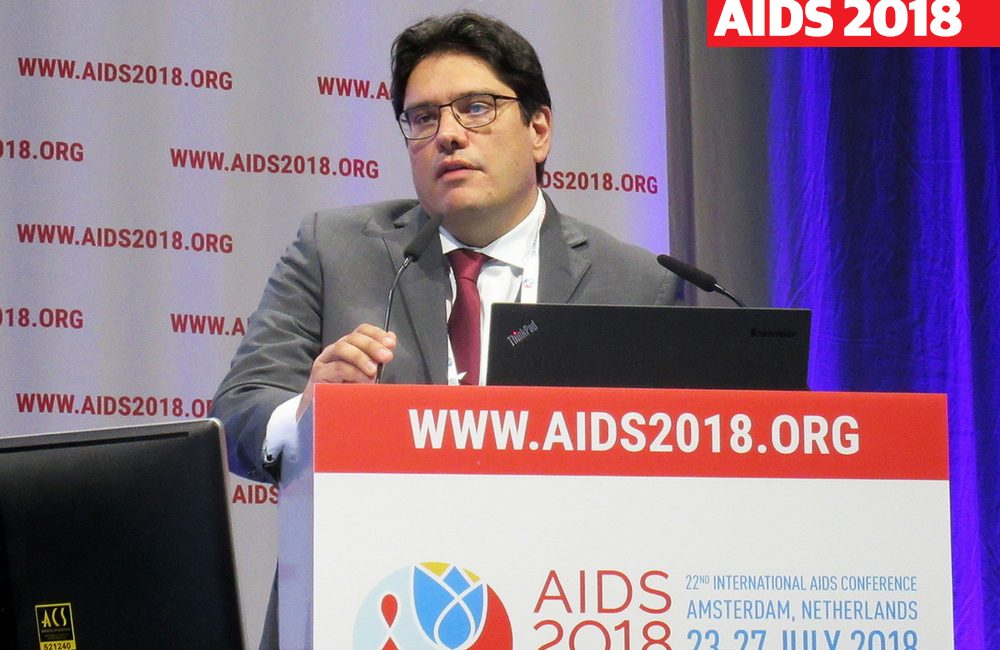
People living with HIV are about twice as likely to develop steatosis, or fat accumulation in the liver, even if they don't have hepatitis B or C co-infection, according to a study presented at the recent 22nd International AIDS Conference (AIDS 2018) in Amsterdam.
Liver disease is a major cause of morbidity and mortality among people living with HIV. Hepatitis B or C virus (HBV or HCV), heavy alcohol consumption, certain antiretroviral medications and other causes of liver injury can lead to the development of liver fibrosis, cirrhosis and steatosis. But these can also occur without such liver-specific risk factors. Previous studies have seen steatosis rates among people with HIV ranging from around 35% to 75%.
Fatty liver disease, associated with metabolic syndrome, is a growing problem as the population becomes more obese. Over time, non-alcoholic fatty liver disease (NAFLD) and its more advanced stage, non-alcoholic steatohepatitis (NASH), can lead to liver function impairment, liver cancer and the need for a liver transplant.
Hugo Perazzo of Fundação Oswaldo Cruz in Rio de Janeiro and colleagues evaluated the prevalence of and risk factors associated with liver steatosis in people with HIV mono-infection – that is, those without HBV or HCV co-infection – compared with HIV-negative individuals.
The study drew from 649 people with HIV followed at the National Institute of Infectology (INI/Fiocruz) and 15,105 HIV-negative people in the Brazilian Longitudinal Study of Adult Health (ELSA-Brasil) cohort.
In the HIV-positive group 58% were men, 23% were black or 'Pardo' (mixed race) and the median age was 44 years. The median body mass index (BMI) was 24.4 (25 and above is considered overweight) and a third had metabolic syndrome, a cluster of cardiovascular risk factors including abdominal obesity, hypertension (high blood pressure), high blood glucose and abnormal lipid levels.
A total of 333 HIV-positive participants were paired with an equal number of HIV-negative people. Although they were approximately matched based on demographic characteristics and metabolic factors, there were some significant differences. The HIV-positive group was younger, had fewer women, were less likely to be black/Pardo and were more likely to have diabetes, while the HIV-negative group had higher average BMI and were more likely to have abnormal lipids, hypertension and metabolic syndrome.
For each participant, the researchers calculated a Fatty Liver Index (FLI) score based on laboratory and physical exam findings including triglyceride and gamma-glutamyl-transferase (GGT) liver enzyme levels, BMI and waist circumference. Liver steatosis was defined as an FLI of 60 or higher.
More than a third of the participants with HIV (35%) were found to have steatosis. HIV infection was an independent risk factor, doubling the likelihood of having fatty liver, Perazzo reported.
HIV-positive people with steatosis were, on average, older, had higher BMI and waist circumference, had a higher CD4 count and had been on antiretroviral therapy (ART) longer than those without. There were no significant differences related to nadir (lowest-ever) CD4 count, current ART regimen or current viral suppression.
About two-thirds (68%) of the HIV-positive people with steatosis had metabolic syndrome, 46% had abnormal lipids, 46% had hypertension, 41% had diabetes and 54% were described as having 'poor clinical management'.
In a multivariate analysis, independent risk factors for fatty liver were HIV infection (odds ratio 2.1), male sex (OR 5.36), being black/Pardo (OR 0.22), higher BMI (OR 1.91), diabetes (OR 5.79), abnormal lipids (OR 2.57) and hypertension (OR 2.56). In addition, higher CD4 count (OR 1.13 per 100 cell/mm3), higher cumulative HIV viral load (OR 1.25 per 10 log copies/ml per year) and poor clinical management (OR 0.36) also increased the risk of steatosis.
"HIV-infected individuals had two-fold higher odds for presence of steatosis compared to uninfected paired controls," the researchers concluded. "Traditional and HIV-specific risk factors were independently associated with liver steatosis in people living with HIV."
They recommended that management of metabolic risk factors should be integrated into HIV care to decrease the burden of liver diseases in this population.
In response to a question, Perazzo said that FibroScan, an imaging method for assessing fibrosis and steatosis, was not available at the time of the study. Session moderator Marina Klein of McGill University in Montreal noted that researchers are looking for more accurate non-invasive biomarkers of fatty liver as it becomes a more prevalent cause of serious liver disease in people with and without HIV.
Perazzo H et al. HIV infection is an independent risk factor for liver steatosis: A study in HIV mono-infected patients compared to uninfected paired controls and associated risk factors. 22nd International AIDS Conference, Amsterdam, abstract THAB0205, 2018.
View the abstract on the conference website.
